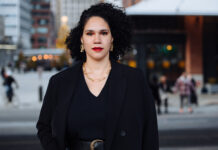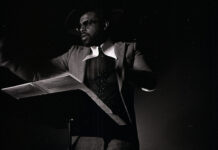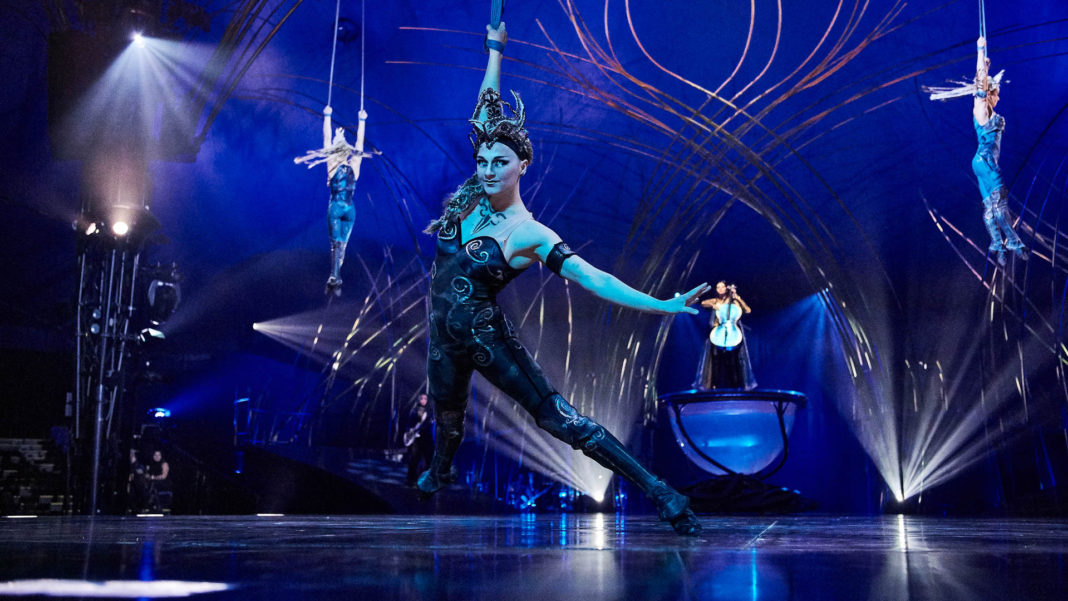When Cirque du Soleil was looking to do a show that featured primarily women, it made sense that the company reached out to Tony Award-winning director Diane Paulus. She currently has the musical Waitress on Broadway and her previous shows there include The Gershwin’s Porgy & Bess and Pippin (where the role of the leading player, previously played by men, was played by Patina Miller – who won a Tony Award as did Paulus). It also made sense to Paulus, who wrote and directed Amaluna. The traveling production opens tonight in San Pedro and will continue through May 26th.
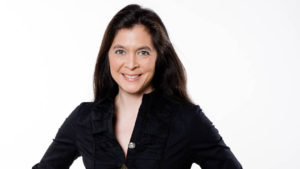
Amaluna had its premiere seven years ago, so when I spoke to Paulus by phone about the show, she had the advantage of perspective, but retained the same passion she seems to have had when she was first approached doing the show.
“This was one of those no-brainer situations,” she says. “I had been a super fan of Cirque du Soleil watching their shows and marveling at them. I got an e-mail asking, ‘would you ever be interested?’ When I heard the follow-up that Guy Laliberté [co-founder of Cirque] thought it should be an homage to women, that kind of sold me immediately.”
As a director keenly interested in storytelling, Paulus thought about what framework would be best for a show that turns out to be 70% women and 30% men and, like all Cirque shows, does not rely on language. So she turned to Shakespeare and Mozart as anchors for her story.

“It was almost like creating a story ballet,” Paulus says of her approach to Amaluna. “I was interested in putting these archetypes on stage that were given an internal sense of the world. What I took from The Tempest was the island where there’s a figure who has magical powers. I made it a woman – Prospera, and she has a daughter, which was also interesting to me. And a coming of age when Miranda meets Ferdinand and goes through the rite of passage. It’s really a mash-up of The Tempest, The Magic Flute, in particular the trials that go on in The Magic Flute. The young couple goes through tests of their love and, back to The Tempest, the men arrive due to a shipwreck.”
What she had to figure out was how to weave the kid of acts Cirque is best-known for within the narrative she had written.

“A Cirque show is not a tent show without incredible acrobatics, so that’s a real base-line thing,” she says of her process. “It’s how you lay up the acrobats. You understand that they are characters with a thru-line. To give you an example, we have a sequence where Miranda is lifted up all the way to the center of the tent and the young lover is trying to catch her. He does the Chinese pole act and it’s a metaphor of reaching up the pole and then at the end of the act he levitates after her. It’s not like the acrobatic act is going to tell the story the way choreography does in a musical, but there are ways to set the act and it is adding to the characters you’re learning to love.”
When she was first asked to “join the circus,” the idea of a female-centric show probably seemed radical. After all, it was 2012. Today it feels completely topical. And Paulus thinks that’s as it should be.
“The idea of an all-woman show was kind of exciting and interesting instead of how necessary,” she says. ” I feel we’re necessary now. The topicality of all-women, in this moment, has expanded. It’s representation. I’ve always felt the theatre and the arts is where we confront the world. That there were top women across the world we could feature, of course, we needed to do that. The stats show us things are getting better, but not always. We have more women in Congress and women of color, but we have more work to do. It’s great to have these moments when things change, like the first time Cirque du Soleil does this. You do have to recognize it and bang the gong so people notice it and then we can move on.”
Paulus, who has two daughters, is passionate about the lesson they learned from the show and the point Amaluna can make to other girls.
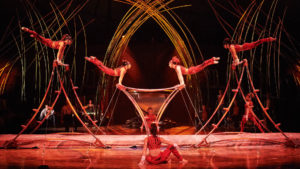
“I feel that no one should tell you what you limits are. Cirque is an art form about pushing your limits. That’s what you really learn. It’s extreme performance. That beauty of seeing people at the top of their game because they worked hard and they have passion and they will not accept the limits of what they can achieve. It’s not just a fun show, it has a deep power.”
There was a time when people used to dream of running away and joining the circus. Laliberté even said of Cirque du Soleil that “inside every adult there’s still child that lingers. We’re giving people the opportunity to dream like children.” Did that sensibility find its way into Paulus?
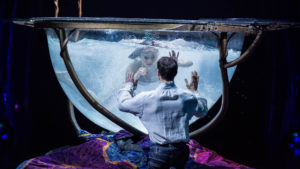
“I don’t think of my experience as dreaming like a child,” she says after pondering the question for a moment. “It’s more like a welcome to a complex world of how it all happens. You go to Montreal and you are invited into the creation room. You put research and pictures and trees and goddesses and everything on the wall. I sat and cut budgets. There’s always the nitty gritty work you have to do. But the idea of letting your mind go anywhere…that’s the dreaming. And the rigor of how you translate that, that was the dream realized.”
For tickets go here.
Featured photo by Markus Moellenberg/(c) 2016 Cirque du Soleil


